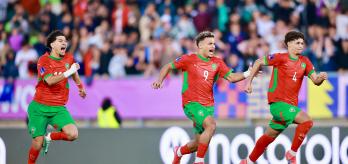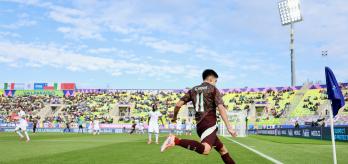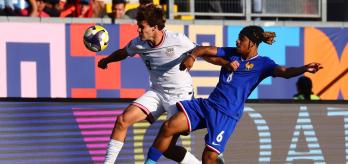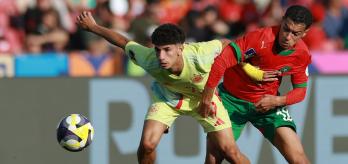Experiencing the tournament environment, different climates and cultures, and facing teams with different strategic approaches gives youth players the chance to test their decision-making and execution of actions against the best players in the world at a similar stage in their development.
Our Technical Study Group and Football Performance Insights Team are on site in Chile for FIFA U-20 World Cup 2025™, and in this article, Marcin Dorna, Sports Director of the Polish Football Association (PZPN), explores Morocco’s build-up strategy from goal kicks against Spain’s high press. In addition, we identify the tactical adaptations made by both teams as they adjusted to each other’s nuanced changes, while we also identify the technical implications of those changes on player decision-making and technical execution.
MOROCCO BUILD-UP FROM GOAL KICK
Operating in a 1-4-4-2 team structure, Morocco’s two centre-backs dropped low alongside their goalkeeper inside the penalty area, with their left centre-back standing over the ball. This was designed to create a 3v2 numerical advantage against Spain’s two pressing forwards.
Both full-backs took up relatively low and wide positions within their defensive third of the pitch. Their two centre-midfielders dropped low, approaching the edge of the penalty area, acting as a double pivot, and attempting to create a numerical advantage to progress the ball centrally. Their two wide midfielders positioned themselves high and wide, pinning Spain’s full-backs on the halfway line to create maximum width and open up the playing space.
Interestingly, their two centre-forwards dropped in deep, creating further numerical supremacy in the centre-midfield area and some conflicts around defensive responsibilities for Spain’s defenders, midfielders and forwards.
SPAIN’S HIGH PRESS AGAINST THE GOAL KICK
Spain spent 7% of their out-of-possession time in the high-press phase and had a player within 12.5 metres of the restart at every Morocco goal kick. Playing in a 1-4-3-3 structure, initially, Spain committed their two wide forward players to the edge of the penalty area, with a focus on pressing Morocco’s centre-backs and/or goalkeeper. Their centre-forward was on the edge of the penalty area, but was overloaded by Morocco’s double-pivot players. Their two attacking midfielders occupied the half spaces, with the responsibility of marshalling the central space, but also to press the nearest Morocco full-back, should the ball be played to them.
Spain’s holding midfielder occupied the central space in front of the two centre-backs, but he too was overloaded by Morocco’s forward players who dropped into the central space. This meant that Spain’s full-backs were both occupied in 1v1s in the wide areas, while their two centre-backs were faced with deciding between remaining in position on the halfway line to protect the central space, or dropping in and marking Morocco’s two centre-forwards.
In addition, in this structure, Spain’s goalkeeper remains in a relatively low position, close to the edge of his penalty area.
In clip 1 below, Dorna highlights the interesting aspects of the two strategies when applied against each other.
“As soon as the ball is played to the goalkeeper, Spain initiate a high-intensity press. However, this does not deter the goalkeeper from playing to his midfielder, even though he too is under heavy pressure. Importantly, his goalkeeper plays to his stronger right foot and he responds quickly, playing a pass to the right centre-back with his first touch. As the right-back becomes a viable passing option, Spain’s left-sided midfielder goes to press him, freeing up the inside space for Morocco’s second pivot player to receive the ball unopposed in a central position. He demonstrates his side’s attacking intention with an early ball in behind Spain’s defensive line, even though he also has options available to switch play out to the opposite side.
“This is a well-orchestrated phase of play where players have a clear understanding of their roles, whether it is to facilitate the creation of space or to receive and progress the ball. Every player has an active and purposeful role.”
Coaching intervention #1
The first adaptation initiated by Spain was made to counteract the numerical supremacy that Morocco’s double pivot achieved in the central area. To do this, they pushed their defensive midfielder forward so that he could mark the second pivot player, effectively going player-for-player in Morocco’s defensive third. This left a large space open behind those players, fully conceding the space that Morocco’s two centre-forwards were dropping into.
As Dorna explains, this adjustment changed the point of opportunity for Morocco and the point of risk for Spain (see clip 2 below).
“As soon as Spain made this tactical adjustment to their high press, Morocco’s players demonstrated excellent game awareness, as they recognised immediately where the new opportunity was to progress their build-up. Their build-up setup is exactly the same as before, but this time, their goalkeeper sees that the numerical supremacy now lies further forward in the space occupied by their two centre-forwards.
“Just before play is started, we can see that Spain’s left centre-back travels in deep to get closer to one of Morocco’s centre-forwards, while the right centre-back pushes on about five yards but does not go all the way into the second centre-forward. In this situation, he must decide whether to stay and defend the central space or to advance and defend the player. Even though he is advanced slightly, his position and movements demonstrate that he is prioritising defending the space and is hoping his right-sided midfielder can cover the centre-forward if the ball is played in.
“As soon as Morocco’s left centre-back plays the ball to his goalkeeper, Spain engage their press and the goalkeeper immediately passes it straight to the centre-forward, breaking two lines of Spain’s defence. He receives on the half-turn, enabling him to play forward to the left midfielder, who is intentionally positioned high and wide, before the play is eventually stopped due to a foul committed.
“Even though Morocco did not vary their team structure in this build-up phase, their players showed real game intelligence by recognising Spain’s tactical adjustment and responding immediately.”
Coaching Intervention #2
To mitigate the risk of leaving an opposition centre-forward free in the central space, Spain made a further adjustment, this time opting to send both centre-backs in deep to mark Morocco’s two centre-forwards and, therefore, leaving the central space between both full-backs (who were also in 1v1 situations) vacant. This adjustment triggered a change in the positioning of Spain’s goalkeeper, as he advanced closer towards the centre circle from his previous position at the edge of his penalty area from the same goal-kick scenario.
For Dorna, this intervention from Spain’s head coach, Paco Gallardo, demonstrated courage and trust in his players, but also his willingness to expose them to challenging scenarios that they will face at senior level, depending on whether the player in possession of the ball is facing pressure or if they are unopposed.
“This approach shows the coach’s intent to develop the players in 1v1 situations. This is important for player development, as senior players must understand when to defend the space, when to defend the player and to recognise when the danger switches from one priority to the other. It is not unusual for centre-backs to be in 1v1 situations in the centre of the pitch when in their defensive line, or for one centre-back to follow a centre-forward who drops into that space between their midfield and defensive line. However, it is not often that coaches will want to leave that central space completely vacant. But, in exposing the players to this scenario, they had to demonstrate their technical agility in how they used their body positions, timing and decision-making skills to adjust between defending against the man and defending the space. This is a good player-development approach.”
In clip 3 below, we see how important this decision-making is for both teams. When Morocco’s goalkeeper recognises that the two centre-backs have engaged a player-marking approach to the centre-forwards, he immediately plays the ball long, looking to exploit the space in behind Spain’s defensive line.
As Dorna explains, “Since Morocco had demonstrated their willingness and ability to play out using short- and medium-range passes, even when under pressure, it became too risky to allow them to have free players in their own half, prompting Spain’s two centre-backs to go in deep. However, by reading the intentions of the goalkeeper, based on the fact that he is unopposed and has sufficient distance from the ball to generate a long kick, both players anticipate the longer ball and respond by leaving the two centre-forwards to prioritise defending the space. They do this in tandem with their left-back, who also tracks centrally to defend the space.”
Developmental points
These scenarios illustrated the game intelligence of players in both teams. Morocco had clearly worked on this build-up phase, with players demonstrating a clear understanding of the attacking opportunities that arose based on how and where they were pressed.
For Spain, they had the tactical and technical versatility to recognise the threats and respond with varying degrees of risk based on the danger posed by Morocco’s attacking strategy. There was an understanding that it can be more important to allow players to operate in 1v1 situations to get good pressure on the ball.
As Dorna concludes, “Both sets of players showed they could both anticipate situations and react to them, using technical and tactical versatility. These are important attributes for young players and need continuous development, further highlighting the importance of competing in these competitions with exposure to different scenarios.”















